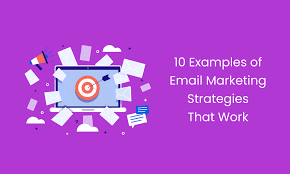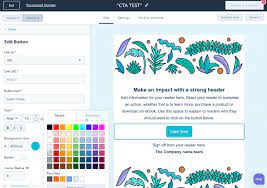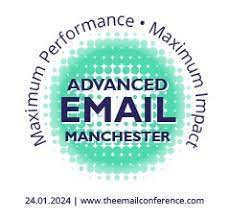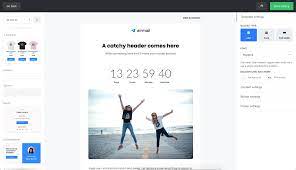Email Marketing Strategy Examples: How to Boost Engagement and Drive Conversions
In today’s digital landscape, email marketing continues to be a powerful tool for businesses to engage with their audience and drive conversions. However, simply sending out generic emails is no longer enough. To make a real impact, businesses need to develop effective email marketing strategies that resonate with their target audience. In this article, we will explore some successful email marketing strategy examples that can help you boost engagement and drive conversions.
Personalized Welcome Emails:
One effective strategy is to send personalized welcome emails to new subscribers. This initial interaction sets the tone for your relationship with them. By addressing them by name and offering a warm welcome, you can create a sense of connection and make them feel valued. Additionally, consider including a special offer or exclusive content in the welcome email as an incentive for them to take action.
Segmentation and Targeted Campaigns:
Segmenting your email list based on demographics, interests, or past purchase behavior allows you to send targeted campaigns that are more relevant to each subscriber. For example, if you have an e-commerce store selling clothing for men and women, segmenting your list by gender can help you send tailored emails highlighting products specific to each group. This personalization increases the chances of engagement and conversions.
Abandoned Cart Recovery Emails:
Cart abandonment is a common challenge for e-commerce businesses. To combat this issue, implement an automated abandoned cart recovery email campaign. Send a series of reminder emails to customers who have left items in their cart without completing the purchase. Include compelling visuals of the abandoned products along with persuasive copy that encourages them to return and complete their purchase.
Customer Retention Emails:
Don’t forget about your existing customers! Sending regular customer retention emails helps nurture relationships and encourages repeat purchases. Consider sending personalized product recommendations based on their previous purchases or offering exclusive discounts as a token of appreciation for their loyalty. These emails can help keep your brand top of mind and foster long-term customer loyalty.
Event Invitations and Reminders:
If your business hosts events, whether online or in-person, email marketing can be a powerful tool to drive attendance. Send out engaging invitations that highlight the benefits of attending and provide clear instructions for registration. Follow up with reminders as the event date approaches to ensure maximum attendance. Consider offering early bird discounts or exclusive perks to incentivize sign-ups.
Post-Purchase Follow-up Emails:
After a customer completes a purchase, it’s essential to follow up with a post-purchase email. Express gratitude for their purchase and provide them with any necessary information such as order tracking details or product usage tips. This not only enhances the customer experience but also opens up opportunities for cross-selling or requesting feedback through review requests.
Remember, successful email marketing strategies require constant monitoring and optimization. Analyze key metrics such as open rates, click-through rates, and conversions to understand what resonates with your audience and make necessary adjustments to improve results.
In conclusion, implementing effective email marketing strategies can significantly boost engagement and drive conversions for your business. By personalizing emails, segmenting your audience, sending targeted campaigns, and leveraging automation, you can create impactful interactions that resonate with your subscribers. Stay creative, experiment with different approaches, and consistently analyze data to refine your strategy over time.
7 Frequently Asked Questions about Email Marketing Strategy Examples in English (UK)
- What are some email marketing strategies?
- What are the 3 types of email marketing?
- How do you create an email marketing strategy?
- What is the strategy of email marketing?
- What are the examples of email marketing types?
- What are some examples of email marketing?
- What are the 4 types of email marketing?
What are some email marketing strategies?
There are several effective email marketing strategies that businesses can implement to engage their audience and drive conversions. Here are some key strategies:
- Personalization: Tailor your emails to individual recipients by using their names, segmenting your audience based on demographics or interests, and delivering content that is relevant to their needs and preferences.
- Welcome Emails: Send a warm welcome email to new subscribers, introducing your brand, setting expectations, and offering them a special incentive or exclusive content to encourage engagement from the start.
- Segmentation: Divide your email list into smaller segments based on specific criteria such as demographics, purchase history, or engagement level. This allows you to send targeted campaigns that resonate with each group.
- Automated Email Campaigns: Utilize automation tools to set up triggered email sequences based on specific actions or events. For example, sending abandoned cart recovery emails or follow-up emails after a purchase.
- Mobile Optimization: Ensure that your emails are optimized for mobile devices since a significant portion of users access their emails through smartphones or tablets. Mobile-friendly designs and concise content will enhance the user experience.
- Compelling Subject Lines: Craft attention-grabbing subject lines that entice recipients to open your emails. Use personalization, urgency, curiosity, or offers to increase the chances of engagement.
- Engaging Content: Create valuable and engaging content in your emails that resonates with your audience’s interests and needs. This can include informative articles, product updates, exclusive discounts, or interactive elements such as quizzes or surveys.
- Call-to-Action (CTA): Clearly define the action you want recipients to take in each email by including a prominent CTA button or link. Make it visually appealing and use persuasive language to encourage clicks.
- A/B Testing: Experiment with different elements of your emails such as subject lines, CTAs, visuals, or copywriting through A/B testing. This allows you to identify what resonates best with your audience and optimize your campaigns accordingly.
- Analytics and Optimization: Regularly monitor key metrics such as open rates, click-through rates, conversions, and unsubscribe rates. Analyze the data to gain insights into the effectiveness of your campaigns and make necessary adjustments for continuous improvement.
Remember, successful email marketing strategies require a combination of creativity, personalization, and data-driven decision-making. Tailor your approach based on your audience’s preferences and consistently refine your strategy to achieve optimal results.
What are the 3 types of email marketing?
The three types of email marketing are:
- Promotional Emails: Promotional emails are designed to promote products, services, or special offers to the subscribers on your email list. These emails typically include sales announcements, discounts, new product launches, or limited-time offers. The goal of promotional emails is to generate immediate sales or conversions.
- Transactional Emails: Transactional emails are triggered by a specific action taken by a customer or subscriber. These emails include order confirmations, shipping notifications, password resets, and receipts. While their primary purpose is to provide important information related to a transaction, transactional emails also present an opportunity to include personalized recommendations or cross-sell/up-sell suggestions.
- Relationship-Building Emails: Relationship-building emails focus on nurturing the relationship between the business and its subscribers/customers. These emails aim to provide value beyond promotional content and establish trust and credibility with the audience. Examples of relationship-building emails include newsletters, educational content, industry insights, blog updates, and customer testimonials. The goal is to engage subscribers and build long-term relationships that can lead to increased loyalty and repeat business.
By incorporating all three types of email marketing into your strategy, you can effectively promote your products/services while also providing valuable content and maintaining a strong connection with your audience.
How do you create an email marketing strategy?
Creating an effective email marketing strategy involves several key steps. Here’s a step-by-step guide to help you develop a successful email marketing strategy:
- Define Your Goals: Start by clearly defining your objectives. What do you want to achieve with your email marketing efforts? Is it to increase sales, generate leads, drive website traffic, or enhance customer engagement? Setting specific and measurable goals will guide your strategy.
- Identify Your Target Audience: Understand who your target audience is and what they are interested in. Develop buyer personas to define their demographics, interests, pain points, and preferences. This information will help you tailor your emails to resonate with their needs.
- Build and Grow Your Email List: Focus on growing your email list organically by offering valuable incentives such as exclusive content, discounts, or free resources in exchange for email sign-ups. Ensure that you comply with relevant data protection regulations when collecting and managing subscriber information.
- Segment Your Email List: Divide your email list into segments based on relevant criteria such as demographics, purchase history, engagement levels, or interests. This allows you to send targeted and personalized emails that are more likely to resonate with each segment.
- Choose an Email Marketing Platform: Select a reliable email marketing platform that suits your needs and budget. Look for features like list segmentation capabilities, automation options, responsive templates, analytics tools, and easy integration with other systems (e.g., CRM or e-commerce platforms).
- Create Compelling Content: Craft engaging and valuable content for your emails that aligns with your audience’s interests and preferences. Use attention-grabbing subject lines, personalized greetings, compelling copywriting techniques, relevant visuals (images or videos), and clear calls-to-action (CTAs).
- Design Mobile-Friendly Templates: Optimize your email templates for mobile devices since a significant portion of recipients open emails on smartphones or tablets. Ensure that the design is responsive and visually appealing across different screen sizes.
- Plan Your Email Campaigns: Develop a content calendar outlining the frequency and timing of your email campaigns. Consider factors like seasonal promotions, product launches, or industry events that may impact your email schedule. Balance promotional emails with informative or educational content to provide value to your subscribers.
- Automate and Personalize: Leverage automation tools to streamline your email marketing efforts. Set up automated welcome emails, abandoned cart recovery emails, birthday greetings, or post-purchase follow-ups. Personalize your emails by addressing subscribers by name and tailoring content based on their preferences or past interactions.
- Test and Analyze: Continuously test different elements of your emails (subject lines, CTAs, visuals) to optimize performance. Track key metrics such as open rates, click-through rates, conversion rates, and unsubscribe rates to evaluate the effectiveness of your campaigns. Use this data to refine your strategy over time.
- Maintain Compliance: Ensure compliance with relevant email marketing regulations such as GDPR or CAN-SPAM Act. Provide clear unsubscribe options and honor opt-out requests promptly.
- Monitor Results and Iterate: Regularly review the performance of your email campaigns against your goals. Identify areas for improvement based on analytics data and feedback from subscribers. Iterate on your strategy by making necessary adjustments to optimize results.
Remember that an effective email marketing strategy is an ongoing process that requires continuous monitoring, analysis, and adaptation based on audience behavior and market trends. Stay informed about best practices in email marketing to stay ahead of the curve and maximize the impact of your campaigns.
What is the strategy of email marketing?
The strategy of email marketing involves planning and implementing a series of steps to effectively use emails as a marketing tool to engage with your audience, build relationships, and drive conversions. Here are some key elements of an email marketing strategy:
- Define Goals: Start by clearly defining your objectives for email marketing. Whether it’s increasing brand awareness, driving sales, or nurturing customer relationships, having specific goals will guide your strategy.
- Build a Targeted Email List: Focus on growing an engaged and relevant email list. Offer incentives such as exclusive content or discounts to encourage visitors to subscribe to your emails. Ensure compliance with data protection regulations and obtain consent from subscribers.
- Segmentation: Divide your email list into segments based on demographics, interests, purchase history, or engagement levels. This allows you to send more targeted and personalized content that resonates with each segment.
- Create Compelling Content: Craft engaging and valuable content that aligns with the interests of your audience segments. Use attention-grabbing subject lines and personalize emails with recipient names whenever possible. Provide valuable information, share industry insights, offer exclusive promotions, or deliver helpful tips.
- Automation: Utilize automation tools to streamline your email campaigns. Set up automated welcome emails for new subscribers, abandoned cart recovery emails for potential customers who left items in their carts, or post-purchase follow-up emails to nurture customer relationships.
- Design and Layout: Pay attention to the design and layout of your emails. Make sure they are visually appealing, mobile-friendly, and easy to read. Use images strategically but ensure they don’t overshadow the main message.
- Call-to-Action (CTA): Include clear and compelling CTAs in your emails that prompt recipients to take action such as making a purchase, signing up for an event, downloading a resource, or sharing feedback.
- Testing and Optimization: Continuously test different elements of your email campaigns like subject lines, content, CTAs, and send times. Analyze metrics such as open rates, click-through rates, and conversions to identify what works best and make data-driven improvements.
- Personalization and Customization: Tailor your emails to each recipient by using their name, referencing past interactions or purchases, and recommending relevant products or content. Personalization helps create a sense of connection and increases engagement.
- Analytics and Tracking: Use email marketing analytics tools to monitor the performance of your campaigns. Track key metrics to evaluate the success of your strategy and make informed decisions for future improvements.
Remember that building trust with your audience is crucial in email marketing. Always provide an easy way for recipients to unsubscribe or manage their preferences, respect their privacy, and deliver value with every email you send.
What are the examples of email marketing types?
There are several types of email marketing that businesses can utilize to engage with their audience and achieve their marketing goals. Here are some examples:
- Welcome Emails: These emails are sent to new subscribers or customers to introduce them to your brand, express appreciation for their interest, and provide important information or resources.
- Promotional Emails: These emails are designed to promote specific products, services, or offers to your subscribers. They often include enticing visuals, compelling copy, and clear calls-to-action (CTAs) to encourage conversions.
- Newsletter Emails: Newsletters are regular emails that provide valuable content, updates, industry news, tips, and insights to your subscribers. They help build trust and establish your brand as an authority in your niche.
- Abandoned Cart Emails: These automated emails are sent to customers who have added items to their shopping cart but haven’t completed the purchase. They serve as reminders and often include incentives or discounts to encourage them to return and complete the transaction.
- Re-engagement Emails: These emails target subscribers who have become inactive or haven’t engaged with your emails for a certain period of time. The purpose is to rekindle their interest by offering exclusive content, special offers, or inviting feedback.
- Transactional Emails: These emails are triggered by specific actions taken by customers, such as order confirmations, shipping notifications, password resets, or account updates. While primarily informative in nature, they can also be used strategically to upsell related products or services.
- Post-Purchase Follow-up Emails: After a customer makes a purchase, these emails express gratitude for their business and may include order details, delivery information, product usage tips, and requests for reviews or feedback.
- Event Invitations/Reminders: If you’re hosting events like webinars or conferences, sending targeted emails with event details and reminders can help drive attendance and engagement.
- Survey/Feedback Emails: These emails are sent to gather valuable insights and feedback from your subscribers or customers. They can help you understand their preferences, improve your products or services, and strengthen customer relationships.
- Social Media Integration Emails: These emails encourage subscribers to connect with your brand on social media platforms, promoting engagement and expanding your online presence.
Remember, the key to successful email marketing is to provide value, personalize content, segment your audience effectively, and continuously analyze and optimize your campaigns based on data-driven insights.
What are some examples of email marketing?
There are several examples of email marketing that businesses can utilize to engage with their audience and achieve their marketing goals. Here are a few common examples:
- Welcome Emails: When someone subscribes to your email list, sending a welcome email is a great way to introduce your brand, set expectations, and provide any necessary information. It’s an opportunity to make a positive first impression and begin building a relationship with the subscriber.
- Promotional Emails: Promotional emails are used to showcase special offers, discounts, or new products/services. These emails aim to create a sense of urgency or excitement among recipients, encouraging them to take advantage of the offer or make a purchase.
- Abandoned Cart Emails: If a customer adds items to their shopping cart but doesn’t complete the purchase, an abandoned cart email can be sent as a gentle reminder. This type of email often includes details about the items left behind and may offer incentives like free shipping or a discount code to encourage the customer to complete their purchase.
- Newsletter Emails: Newsletters are regular emails that provide subscribers with updates about your business, industry news, educational content, or exclusive insights. They help nurture relationships with subscribers by providing valuable and relevant information.
- Event Invitation Emails: If you’re hosting an event such as a webinar, workshop, or conference, sending event invitation emails is crucial for driving attendance. These emails typically include event details, registration links, speaker information, and any other relevant information that encourages recipients to RSVP.
- Customer Feedback Emails: Gathering feedback from customers is essential for improving products/services and understanding customer satisfaction levels. Customer feedback emails can be sent after a purchase or interaction with your brand and typically include surveys or review requests.
- Re-engagement/Win-back Emails: When subscribers become inactive or haven’t engaged with your emails for some time, re-engagement/win-back emails can be sent in an attempt to revive their interest. These emails often include special offers, personalized recommendations, or reminders of the value they can receive by staying connected.
Remember, the key to successful email marketing is to provide value, personalization, and relevance to your audience. By understanding your target audience and tailoring your emails accordingly, you can create effective email campaigns that drive engagement and conversions.
What are the 4 types of email marketing?
There are four main types of email marketing:
- Promotional Emails: These emails are focused on promoting a product, service, or special offer. They aim to generate sales or conversions by highlighting the benefits, features, or discounts available. Promotional emails can be sent to your entire subscriber list or targeted segments based on their interests and past purchase behavior.
- Transactional Emails: These emails are triggered by a specific action or transaction made by the recipient. Examples include order confirmations, shipping notifications, password resets, and receipts. While transactional emails serve a functional purpose, they also present an opportunity to engage customers further by including personalized recommendations or cross-selling suggestions.
- Relational Emails: Relational emails are designed to build and nurture relationships with subscribers. They focus on providing value and establishing trust rather than directly selling products or services. Examples include welcome emails, newsletters, educational content, blog updates, and customer surveys. Relational emails help strengthen brand loyalty and keep subscribers engaged over time.
- Automated Emails: Automated emails are sent based on predefined triggers or actions taken by subscribers. They allow you to deliver timely and relevant messages without constant manual effort. Examples of automated emails include welcome series for new subscribers, abandoned cart recovery emails, re-engagement campaigns for inactive subscribers, birthday offers, and anniversary reminders.
By incorporating a mix of these email types into your marketing strategy, you can effectively engage with your audience at different stages of their customer journey and maximize the impact of your email campaigns.




